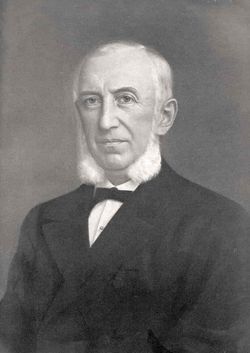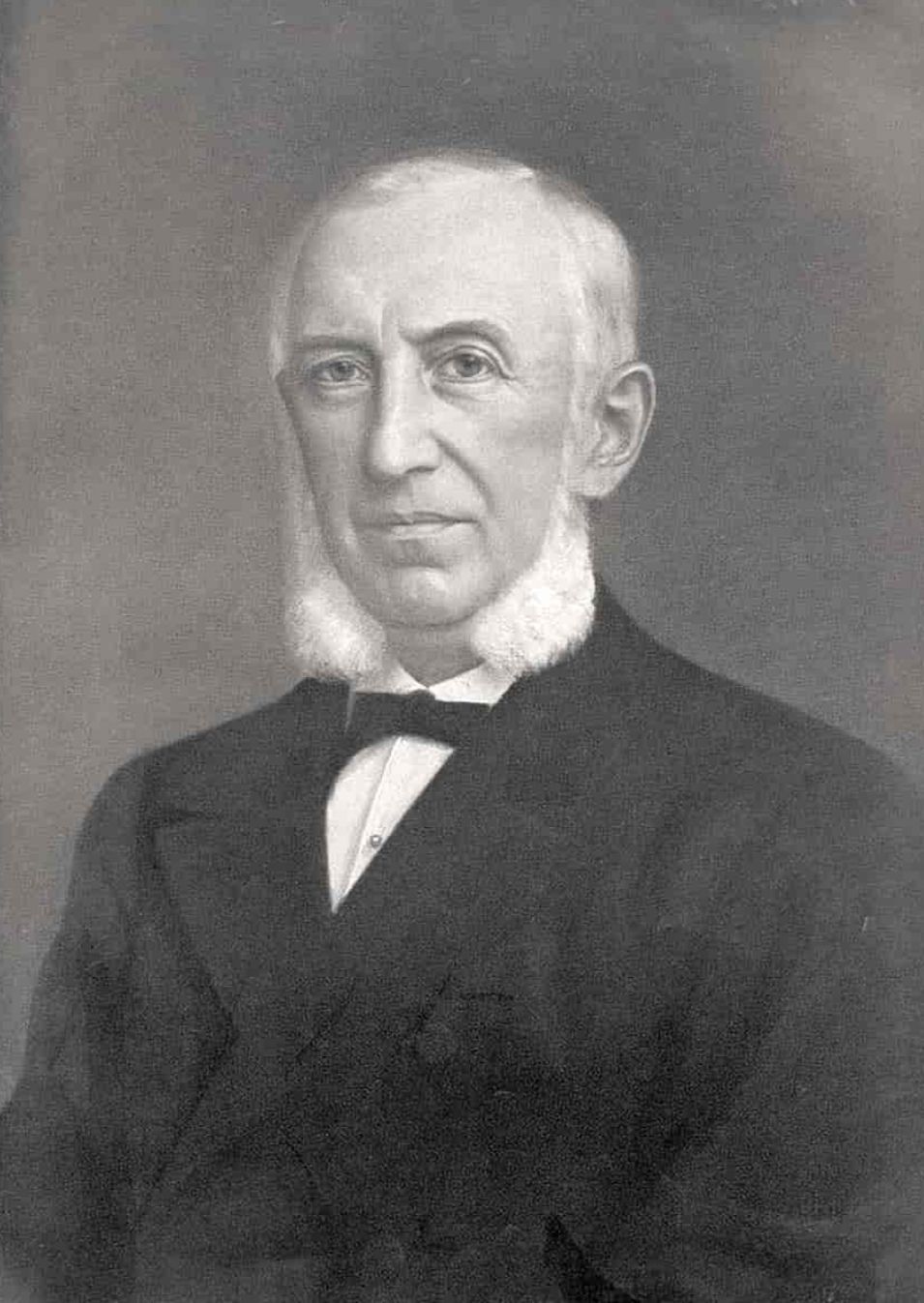Parents: Merchant, later proprietor Henrik Leganger Sundt (1775–1820) and Sophie Catharina Ameln (1782–1852). Married on 15 October 1848 in Bergen to Jacoba Johanne Kramer (10 July 1825–18 December 1888), daughter of merchant, consul general Gerrit Kramer (1792–1870) and Catharina Christina Blaauw (1802–80). Tremenning (second cousin )by Eilert Sundt (1817–75); father-in-law of Peter Jebsen (1824–92); maternal grandfather of Christian Smit (1886–1960).
Throughout the last half of the 19th century, C. Sundt was Bergen's foremost self-made rich man, diverse community support, tireless benefactor and uncrowned head. He stood as the epitome of hardworking, thrifty, sane and all-rounder.
Sundt spent his early childhood years in Tysnes in Sunnhordland, where his father owned the farm Nymark. He died without leaving a fortune when the son was only four years old, and the widow moved back to Bergen with her four children and opened a small hawker shop in Hollendergaten to support the family. After a few years of schooling, Christian had to take part in shop work. In 1835 he was linked to the manufacturing firm Edvard Hambro as a dispatcher, clerk and later with partial responsibility for purchasing goods abroad. It gave him product knowledge and supplier acquaintances. 10 years later he received an offer to become a partner in the company, but declined and instead started his own wholesale and retail manufacturing business under the name C. Sundt with large loans.
The timing was favorable, because in the same year (1845) the first Norwegian cotton spinning mills were started, and the following year Peter Jebsen (who would later become Sundt's son-in-law) established the country's first cotton weaving mill, Arne Fabrikker. Outside Europe, there was strong growth in the production of textile and manufactured goods. The turnover of clothing and decorative items also skyrocketed in Norway. The profit in wholesale and retail trade with such goods could be very high. Sundt built up an efficient system with a network of sellers and fast shipments for its goods all over Western Norway and Northern Norway, with Bergen as the wholesale center. The retail trade was modernized according to continental models. This spilled over into commercial life elsewhere in Bergen. He constantly sought to underpin his hegemony through exclusive agreements and by being at the forefront of developments.
Sundt also started as a private banker and invested a large part of his fortune in shares in almost all Bergen-built ships where his company received the equipment deliveries. He therefore gained a reputation as a large shipowner and owner and was, among other things, co-stakeholder in Det Bergenske Dampskibsselskab and director of the first American Line (1871). He also invested in industry, i.a. Tangens Gardinfabrik.
For 29 years, Sundt ran his business until in 1874, at the age of 58, he left it to his son Gerhard and two employees in the company. For the following 27 years, he was busy managing his large fortune and with his numerous board and trust positions. He was a co-founder of the Society for the Promotion of Norwegian Fishermen, a board member of Bergens Privatbank from 1855 until his death and a member of the Bergen city council continuously for more than 40 years (1854–98). He became the powerful magnate of his day in Bergen.
Sundt donated large amounts to social, cultural and scientific purposes and also created 11 endowments. The lion's share of the capital in these legacies was tied to purposes for the benefit of relatives. His fortune was NOK 8 million when he died, which corresponds to at least NOK 435 million in today's money value. His previous donations accounted for almost half of his fortune in 1901. Sundt collected art and took advice here from his close friend, shipbuilder Ananias Dekke; In 1889 he bought a large part of Christiania merchant Peter Simonsen's art and antiques collection and donated it to the Vestlandske Kunstindustrimuseum.
Christian Sundt was not a man for original and grand views or bold projects outside his own business. He was clear-sighted, long-term planning and risk-averse, but at the same time methodical and careful; his father's decline as a businessman seems to have made him immune to anything speculative and impulsive. His demeanor was mature, restrained and skeptical. He showed no emotion, but exuded a confident calm.
The company Sundt & Co. also grew after the founder's death. The company was converted into a limited company in 1902 and reorganized a few years later. Times changed, and in 1931 the company came out of the family. It was disbanded in the 1980s, but the characteristic and listed functional department store at Torgallmenning from 1938 still bears the name Sundt. In 1903, a newly constructed street on Strandsiden in Bergen was named C. Sundts street.
Parents: Merchant, later proprietor Henrik Leganger Sundt (1775–1820) and Sophie Catharina Ameln (1782–1852). Married on 15 October 1848 in Bergen to Jacoba Johanne Kramer (10 July 1825–18 December 1888), daughter of merchant, consul general Gerrit Kramer (1792–1870) and Catharina Christina Blaauw (1802–80). Tremenning (second cousin )by Eilert Sundt (1817–75); father-in-law of Peter Jebsen (1824–92); maternal grandfather of Christian Smit (1886–1960).
Throughout the last half of the 19th century, C. Sundt was Bergen's foremost self-made rich man, diverse community support, tireless benefactor and uncrowned head. He stood as the epitome of hardworking, thrifty, sane and all-rounder.
Sundt spent his early childhood years in Tysnes in Sunnhordland, where his father owned the farm Nymark. He died without leaving a fortune when the son was only four years old, and the widow moved back to Bergen with her four children and opened a small hawker shop in Hollendergaten to support the family. After a few years of schooling, Christian had to take part in shop work. In 1835 he was linked to the manufacturing firm Edvard Hambro as a dispatcher, clerk and later with partial responsibility for purchasing goods abroad. It gave him product knowledge and supplier acquaintances. 10 years later he received an offer to become a partner in the company, but declined and instead started his own wholesale and retail manufacturing business under the name C. Sundt with large loans.
The timing was favorable, because in the same year (1845) the first Norwegian cotton spinning mills were started, and the following year Peter Jebsen (who would later become Sundt's son-in-law) established the country's first cotton weaving mill, Arne Fabrikker. Outside Europe, there was strong growth in the production of textile and manufactured goods. The turnover of clothing and decorative items also skyrocketed in Norway. The profit in wholesale and retail trade with such goods could be very high. Sundt built up an efficient system with a network of sellers and fast shipments for its goods all over Western Norway and Northern Norway, with Bergen as the wholesale center. The retail trade was modernized according to continental models. This spilled over into commercial life elsewhere in Bergen. He constantly sought to underpin his hegemony through exclusive agreements and by being at the forefront of developments.
Sundt also started as a private banker and invested a large part of his fortune in shares in almost all Bergen-built ships where his company received the equipment deliveries. He therefore gained a reputation as a large shipowner and owner and was, among other things, co-stakeholder in Det Bergenske Dampskibsselskab and director of the first American Line (1871). He also invested in industry, i.a. Tangens Gardinfabrik.
For 29 years, Sundt ran his business until in 1874, at the age of 58, he left it to his son Gerhard and two employees in the company. For the following 27 years, he was busy managing his large fortune and with his numerous board and trust positions. He was a co-founder of the Society for the Promotion of Norwegian Fishermen, a board member of Bergens Privatbank from 1855 until his death and a member of the Bergen city council continuously for more than 40 years (1854–98). He became the powerful magnate of his day in Bergen.
Sundt donated large amounts to social, cultural and scientific purposes and also created 11 endowments. The lion's share of the capital in these legacies was tied to purposes for the benefit of relatives. His fortune was NOK 8 million when he died, which corresponds to at least NOK 435 million in today's money value. His previous donations accounted for almost half of his fortune in 1901. Sundt collected art and took advice here from his close friend, shipbuilder Ananias Dekke; In 1889 he bought a large part of Christiania merchant Peter Simonsen's art and antiques collection and donated it to the Vestlandske Kunstindustrimuseum.
Christian Sundt was not a man for original and grand views or bold projects outside his own business. He was clear-sighted, long-term planning and risk-averse, but at the same time methodical and careful; his father's decline as a businessman seems to have made him immune to anything speculative and impulsive. His demeanor was mature, restrained and skeptical. He showed no emotion, but exuded a confident calm.
The company Sundt & Co. also grew after the founder's death. The company was converted into a limited company in 1902 and reorganized a few years later. Times changed, and in 1931 the company came out of the family. It was disbanded in the 1980s, but the characteristic and listed functional department store at Torgallmenning from 1938 still bears the name Sundt. In 1903, a newly constructed street on Strandsiden in Bergen was named C. Sundts street.
Sponsored by Ancestry
Advertisement
Explore more
Sponsored by Ancestry
Advertisement


